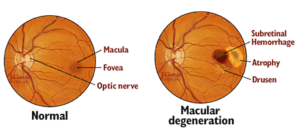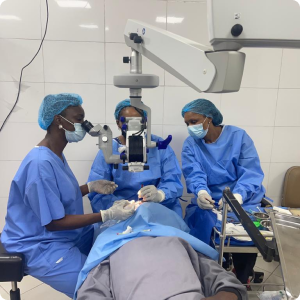Age-Related Macular Degeneration

Age-related macular degeneration is the most common cause of severe loss of eyesight among people 50 and older. Only the center of vision is affected with this disease. It is important to realize that people rarely go blind from it.
AMD affects the central vision, and with it, the ability to see fine details. In AMD, a part of the retina called the macula is damaged. In advanced stages, people lose their ability to drive, to see faces, and to read smaller print. In its early stages, AMD may have no signs or symptoms, so people may not suspect they have it.
Types of Age-Related Macular Degeneration and Causes
The two primary types of age-related macular degeneration have different causes:
-
Dry: This type is the most common. About 80% of those with AMD have the dry form. Its exact cause is unknown, although both genetic and environmental factors are thought to play a role. This happens as the light-sensitive cells in the macula slowly break down, generally one eye at a time. The loss of vision in this condition is usually slow and gradual. It is believed that the age-related damage of an important support membrane under the retina contributes to dry age-related macular degeneration.
-
Wet: Though this type is less common, it usually leads to more severe vision loss in patients than dry AMD. It is the most common cause of severe loss of vision. Wet AMD happens when abnormal blood vessels start to grow beneath the retina. They leak fluid and blood — hence the name wet AMD — and can create a large blind spot in the center of the visual field.
Risk Factors
There are several risk factors that can contribute to developing age-related macular degeneration, including:
- Being 50 and older
- Eating a diet high in saturated fat
- Smoking
- High blood pressure or hypertension
Symptoms
Each individual may experience symptoms differently. Symptoms may include:
- Blurry or fuzzy vision
- Difficulty recognizing familiar faces
- Straight lines appear wavy
- A dark, empty area or blind spot appears in the center of vision
- Loss of central vision, which is necessary for driving, reading, recognizing faces and performing close-up work
The presence of drusen, which are tiny yellow deposits in the retina, is one of the most common early signs of age-related macular degeneration. It may mean the eye is at risk for developing more severe age-related macular degeneration. These will be visible to your doctor during an eye exam.
The symptoms of age-related macular degeneration may look like other eye conditions. Speak with an eye care professional for diagnosis.
Diagnosis
- Visual acuity test. This common eye chart test measures vision ability at various distances.
- Pupil dilation: The pupil is widened with eyedrops to allow a close-up examination of the eye’s retina.
- Fluorescein angiography. Used to detect wet age-related macular degeneration, this diagnostic test involves a special dye injected into a vein in the arm. Pictures are then taken as the dye passes through the blood vessels in the retina, helping the doctor evaluate if the blood vessels are leaking and whether or not the leaking can be treated.
- Amsler grid: Used to detect wet age-related macular degeneration, this test uses a checkerboardlike grid to determine if the straight lines in the pattern appear wavy or missing to the patient. Both indications may signal the possibility of age-related macular degeneration.
Treatment
- Your age, overall health and medical history
- Extent and nature of the disease
- Your tolerance for specific medications, procedures or low-vision therapies
- Expectations for the course of the disease
- Your opinion or preference
Currently, there is no treatment for dry age-related macular degeneration, though vision rehabilitation programs and low-vision devices can be used to build visual skills, develop new ways to perform daily living activities and adjust to living with age-related macular degeneration.
The main treatment for wet AMD is the injection of medications called anti-VEGF agents. VEGF stands for vascular endothelial growth factor. A high level of VEGF in the eye is linked to the formation of the abnormal blood vessels that cause much of the damage in wet AMD. Anti-VEGF agents are used to combat the disease process and reduce the damaging effects of these leaky abnormal blood vessels. They are also able to effectively stabilize vision in many patients.
In some patients, anti-VEGF injections actually improve the level of visual acuity. Anti-VEGF medications are administered by injecting them directly into the affected eye. Although this sounds daunting, the procedure is done with a very fine needle and under the cover of numbing (anesthetic) eyedrops, so patients are usually very comfortable. Anti-VEGF treatment is usually administered regularly over time, requiring multiple injections to maintain the treatment effect, and your retinal physician will discuss the best treatment schedule for you. In selected patients, other treatments, such as laser therapy, can be used, if necessary.
Complications of Age-Related Macular Degeneration
Age-related macular degeneration can result in severe loss of central vision but rarely causes blindness. It can, however, make it difficult to read, drive or perform other daily activities that require fine central vision. In AMD, the health of the peripheral retina is unaffected, so patients can rest assured that their peripheral (side) vision, and their ability to walk around without bumping into things, is usually preserved.
Macular degeneration is the deterioration/breakdown of the macula. The macula is a small area in the retina at the back of the eye that allows you to see fine details clearly and perform activities such as reading and driving. When the macula does not function correctly, your central vision can be affected by blurriness, dark areas or distortion.
Macular degeneration affects your ability to see near and far, and can make some activities like threading a needle or reading difficult or impossible.

Although macular degeneration reduces vision in the central part of the retina. It does not affect the eye’s side or peripheral vision. For example, you could see the outline of a clock but not be able to tell what time it is.
Macular degeneration alone does not result in total blindness. Even in more advanced cases, people continue to have some useful vision and are often able to take care of themselves. In many cases, macular degeneration’s impact on your vision can be minimal.
Causes
Many older people develop macular degeneration as part of the body’s natural aging process. There are different kinds of macular problems but most common is age-related macular degeneration (AMD). Exactly why it develops is not known, and no treatment has been uniformly effective.
Types of AMD
The two most common types of AMD are the “dry” (atrophic) and the “wet” (exudative). Most people have the atrophic form of AMD. It is caused by aging and thinning of the tissues of the macula. Vision loss is usually gradual.The exudative or “wet” form of macular degeneration accounts for about 10% of all AMD cases. It results when abnormal blood vessels form underneath the retina at the back of the eye. These new blood vessels leak fluid or blood and blur central vision. Vision loss may be rapid and severe.
Symptoms
- Blurred vision
- A dark or empty area appears in the center of vision
- Straight lines look distorted; they appear wavy
Diagnosis
- Vision test in which you look at a chart that resembles graph paper (Amsler grid)
- Viewing the macula with an ophthalmoscope
- Taking special photographs of the eye called fluorescein angiographs to find abnormal blood vessels under the retina.
Treatment
Though, there is currently no cure for macular degeneration, there are treatments that can help reduce vision loss:
- Vitamins: A large scientific study showed that people at risk for developing advanced stages of AMD lowered their risk by about 25% when treated with a high dose combination of Vitamin C, Vitamin E, beta carotene and zinc.
- Laser Surgery: Certain types of “wet” macular degeneration can be treated with laser surgery, a brief outpatient procedure. High-energy laser light can sometimes be used to destroy actively growing abnormal blood vessels that occur in age-related macular degeneration.
- Photodynamic therapy: A focused beam of light is used to slow or stop leaking blood vessels that damage the macula. It is a two-step treatment in which a light-sensitive drug is used to damage the abnormal blood vessels. A medication is injected into the bloodstream to be absorbed by the abnormal blood vessels in the eye. The doctor then shines a cold laser into the eye to activate the drug, damaging the abnormal blood vessels.
